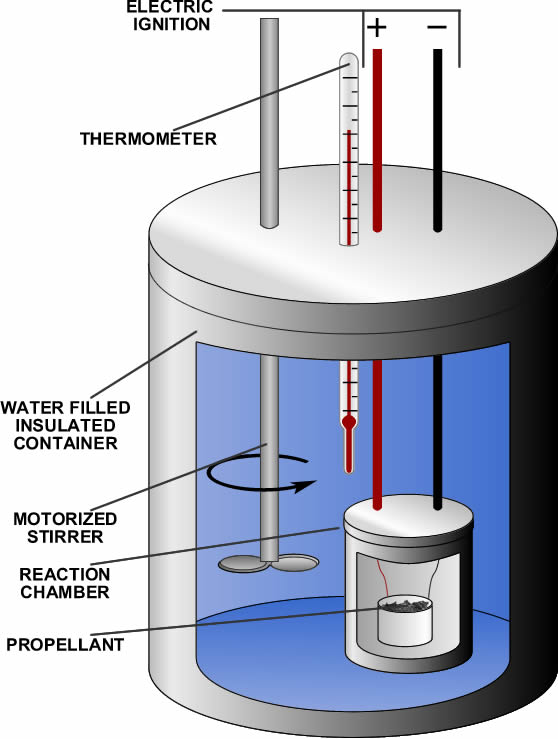Home | Glossary | Resources | Help | Contact Us | Course Map
Archival Notice
This is an archive page that is no longer being updated. It may contain outdated information and links may no longer function as originally intended.
Testing, Grading, and Blending
Each new batch of propellant is tested for performance against a retained reference lot of that propellant. The reference lot is generally the first successful lot produced.
Laboratory testing involves a calorimeter bomb, which is a closed, fixed-volume vessel used to measure heat production from a known mass of flammable material. The new lot of powder is tested in the calorimeter bomb and its heat production compared to that of the reference lot. If the heat production tests match the reference lot (within a small tolerance), the new batch moves to ballistic testing.
For each propellant type or grade developed, a number of cartridges are loaded with the reference lot. The critical assembly information for these cartridges is carefully recorded along with the pressure and velocity results. A sample of each new batch is loaded exactly like the reference loads and tested for pressure and velocity. If the results match those of the reference lot (within a small tolerance), the new batch is approved for packaging and shipment.
Ballistic testing reflects the potential use of each propellant. For example, some propellants are suitable for both shotshell and handgun cartridges. They would be tested in cartridges appropriate to each type of firearm.
If the new batch fails to meet either heat production or ballistic tests, existing samples of powder with faster or slower energy release rates may be blended with the new batch to adjust the performance to meet specifications.
Canister and Bulk
A canister propellant is sold in small quantities to hobbyists who reload ammunition. Each cartridge is limited as to how much powder can be safely loaded behind a particular bullet weight or style. Most bullet and propellant manufacturers have tested a range of cartridges with many propellant and bullet combinations and published the data in reloading manuals.
| 135 gr SPEER Short Barrel Gold Dot HP Coal Tested 1.450" Part Number 4014 BC=0.141 SD=0.151 |
||||
| Propellant |
Start Charge, |
Start Charge Velocity |
Max Charge, |
Max. Charge Velocity |
| Power Pistol | 6.0 | 983 | 6.4 | 1065 |
| AA #5 | 6.6 | 1000 | 7.0 | 1052 |
| AA #7 | 7.8 | 954 | 8.2 | 1030 |
| HS-6 | 6.8 | 944 | 7.2 | 1027 |
| Viht. 3N37 | 6.0 | 969 | 6.4 | 1007 |
| Unique | 4.8 | 867 | 5.2 | 988 |
| H. Universal | 5.0 | 937 | 5.2 | 977 |
| PB | 4.3 | 818 | 4.7 | 936 |
|
Bold type denotes MAXIMUM loads; use with caution. Test Conditions Case: SPEER; Primer: CCI® 500; Test Firearm: S&W M14; Barrel: 6" 1-18 ¾" twist; |
||||
Bulk propellants are sold to manufacturers that possess standard pressure-testing equipment making reliance on published data unnecessary. Based on concurrent testing, the lot control for bulk propellants can be less rigorous because the ammunition manufacturer determines the proper charge weight at the time of loading.
Projectiles
Projectiles are manufactured through multiple methods. The following are some of the methods that have been and are currently used for manufacturing projectiles:
- Casting
- Swaging
- Drop shot production
- Current manufacture
- Lead free
- Jacketed
- Cup and draw operations
Additional Online Courses
- What Every First Responding Officer Should Know About DNA Evidence
- Collecting DNA Evidence at Property Crime Scenes
- DNA – A Prosecutor’s Practice Notebook
- Crime Scene and DNA Basics
- Laboratory Safety Programs
- DNA Amplification
- Population Genetics and Statistics
- Non-STR DNA Markers: SNPs, Y-STRs, LCN and mtDNA
- Firearms Examiner Training
- Forensic DNA Education for Law Enforcement Decisionmakers
- What Every Investigator and Evidence Technician Should Know About DNA Evidence
- Principles of Forensic DNA for Officers of the Court
- Law 101: Legal Guide for the Forensic Expert
- Laboratory Orientation and Testing of Body Fluids and Tissues
- DNA Extraction and Quantitation
- STR Data Analysis and Interpretation
- Communication Skills, Report Writing, and Courtroom Testimony
- Español for Law Enforcement
- Amplified DNA Product Separation for Forensic Analysts


